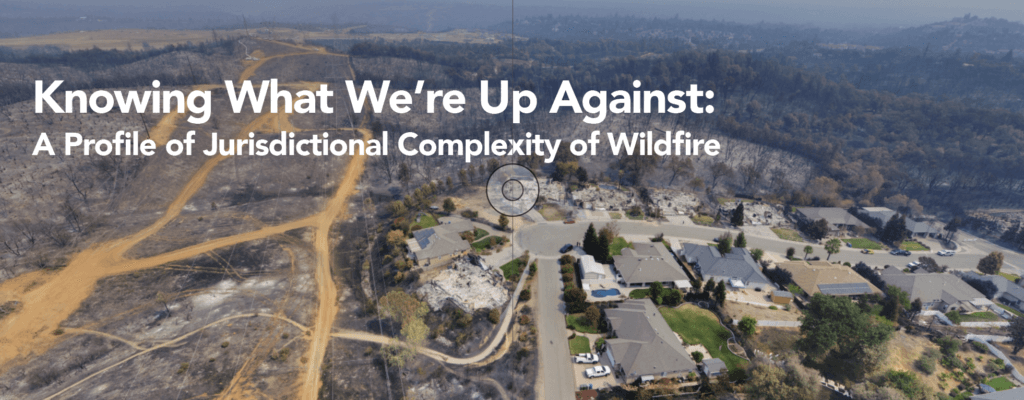
Is yesterday’s fire organization equipped to deal with today’s complex wildfires?
by Branda Nowell, Toddi Steelman, Anne-Lise Velez, Kate Albrecht, Sarah Baines, Shannon McGovern, Honey Minkowitz, Elliot Nauert, and Ryan Scott
There is an on-going narrative in the media and among the fire community that wildfire is increasingly complex. Increasing complexity can mean a lot of different things. What we know the most about are the biophysical and economic indicators. Specifically, we know that wildfires are generally getting larger and more expensive. Larger fires may be affecting more land management jurisdictions, adding another layer of complexity. This has implications for the type of fire organizations necessary to manage this kind of increasing complexity. It also has implications for how we prepare agency administrators and incident management teams to co-manage this jurisdictionally complex environment – raising the question: Is yesterday’s fire organization equipped to deal with today’s complex wildfires?
It’s difficult to prepare for a challenge we don’t fully understand. In 2017, our team set out on a project, funded by the Joint Fire Science Program, to learn more about how stakeholders were co-managing jurisdictionally complex wildfires. Since then, we’ve spoken to over a hundred agency administrators and incident commanders involved in jurisdictionally complex incidents concerning lessons they’re learning about co-management.
However, while we were able to learn important lessons from this sub-set of jurisdictionally complex wildfires, a critical piece of the puzzle was missing. We didn’t know how the wildfires we studied compared with Type 1 and 2 wildfires nationally. Were our fires extreme, black swan events? Or were these wildfires representative of what Type 1 and 2 fires looked like in 2018? We needed to find out.
The Fire Chasers’ Jurisdictional Complexity Project aggregated data from the 2018 wildfire year to create a portrait of land management jurisdictional complexity and associated fire organizations with all National Interagency Coordination Center (NICC) reported Type 1 and Type 2 wildfires occurring during that calendar year. The first step was to identify all wildfires that required either a Type 1 or 2 incident management team (IMT). Data was sourced from the NICC, which keeps a record of all Type 1 and 2 fires for the fire year. Once this population was identified, all Incident Command System (ICS) 209 reports were downloaded for each incident and analyzed. These data were triangulated against additional information taken from fire perimeter maps archived at the National Interagency Fire Center. The resulting data speaks to both the jurisdictional make up of NICC reported Type 1 and 2 incidents in 2018 as well as the nature of the fire organizations that were created to manage this complexity.
Type 1 and 2 Wildfire Incidents by Geographic Area Command Centers
A first indicator of complexity is simply the deployments of Type 1 and 2 incident management teams.
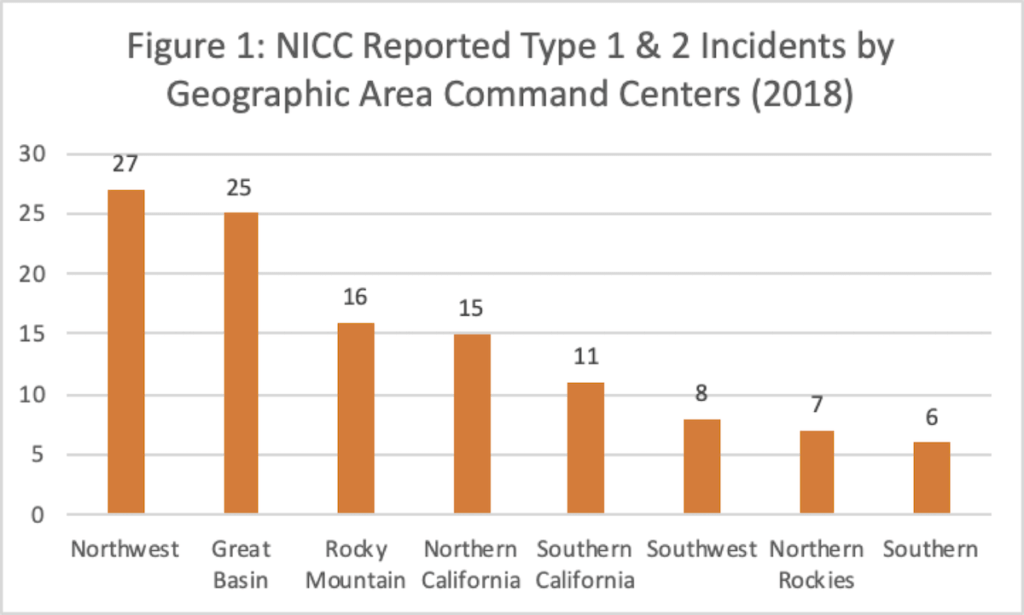
Jurisdictional Complexity of Type 1 and Type 2 Wildfires
Next, we wanted to understand the jurisdictional complexity of these 115 wildfires. Analysis, which considered international, federal, tribal, state, and local land jurisdictions, indicated that on average, a NICC reported Type 1 or 2 wildfire in 2018 impacted three different land jurisdictions. 2018 NICC reported Type 1 and 2 wildfires ranged from single jurisdiction wildfires such as the Goose Creek Fire in Nevada to fires involving numerous local, state, federal, and tribal jurisdictions. As shown in the heat map in Figure 2, Northern and Southern California experienced the highest complexity in 2018 in terms of the total number of land management jurisdictions affected.
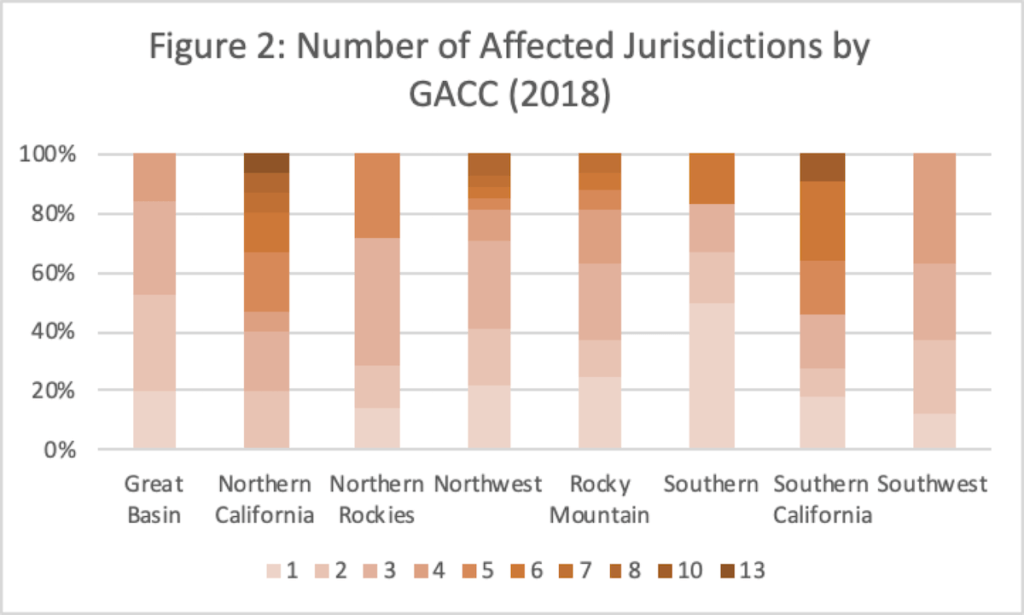
Next, we wanted to know the extent to which this jurisdictional complexity was distributed across levels of government. Specifically, we wanted to know how many levels of international, federal, tribal, state, and local government were involved in each of the 115 incidents. This was important because our previous research indicated that co-managing between levels of government, such as between federal and state land agencies, may have additional challenges. Results from the 2018 fire season indicated that the majority of NICC reported Type 1 and Type 2 wildfires involved at least two jurisdictional levels of government. The most jurisdictionally complex incidents of 2018, such as the Klondike Fire in Oregon, involved co-management among federal, tribal, state, and local levels of government. Forty-two percent of NICC reported Type 1 and 2 fires in 2018 involved at least three levels of government. In terms of levels of government in wildfires by GACC, Figure 3 shows that California had the greatest complexity in 2018, with approximately one third of incidents in California involving four levels of government. However, high jurisdictional complexity was relatively common nationally.
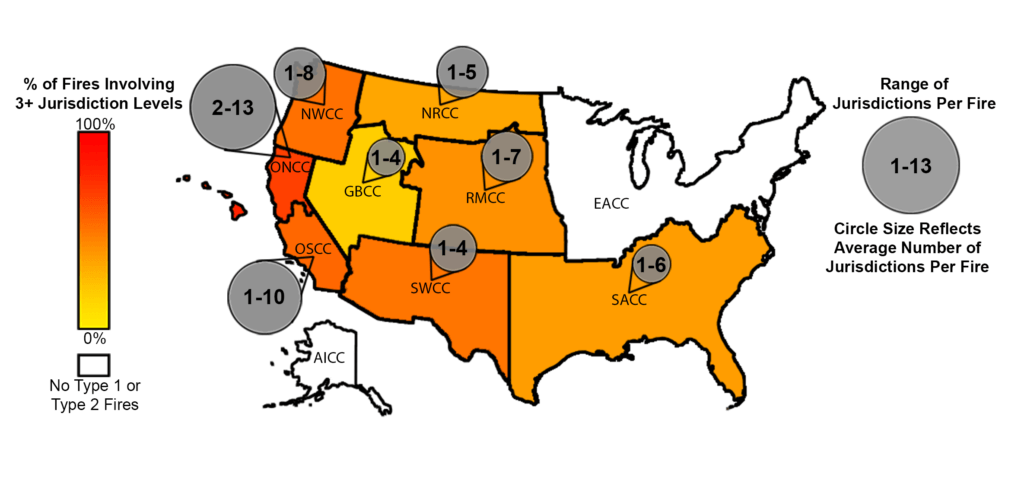
Fire Organizations for Co-managing Jurisdictional Complexity
Our findings indicate NICC reported Type 1 and 2 incidents in 2018 commonly involved three or more land jurisdictions representing multiple levels of government. In terms of the most complex wildfires, we saw incidents involving up to 13 different land management jurisdictions spanning four levels of government. There was clearly a lot to co-manage.
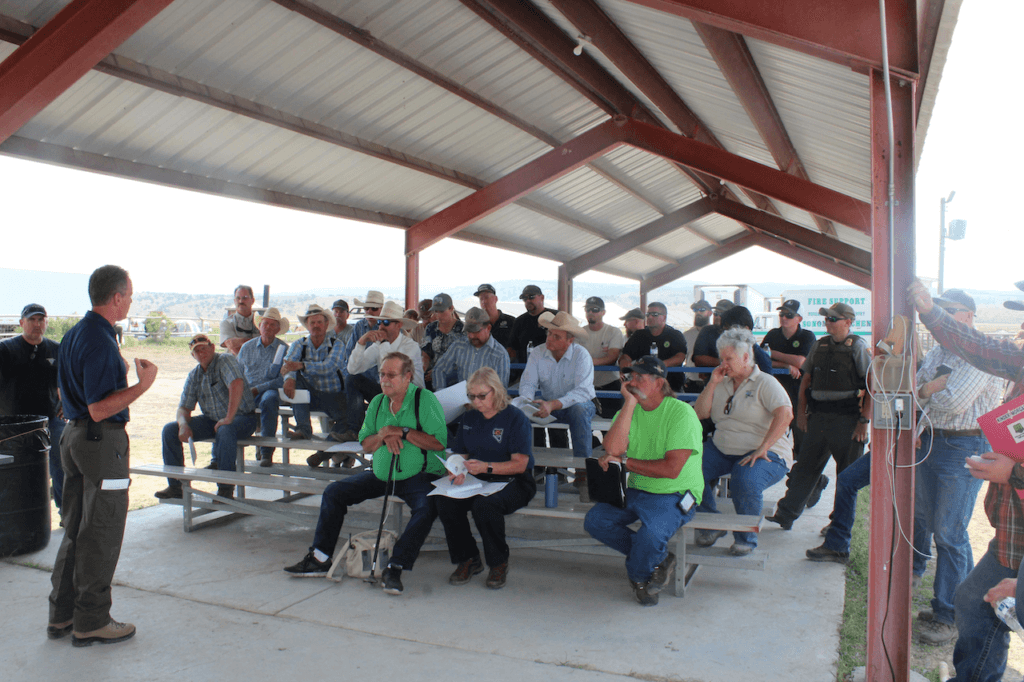
What we know less about is how agency administrators and incident commanders are co-managing this complexity. There are multiple tools within the Incident Command System for building organizations to govern across jurisdictions during an incident. Multiple jurisdictions can issue a joint delegation of authority to the same IMT to manage an incident on their collective behalf. Jurisdictions can elect to have their own incident commander but join into unified command with other incident commanders to ensure continuity and coordination of operations.
If the topography is suitable, fires can be geographically zoned on jurisdictional boundaries and assigned to different IMTs. Zones can be coordinated through area command structures. We know that, as complexity increases, multiple tools are often used in combination. For example, the 2018 Ferguson Fire in California had a federal Type 1 IMT under a joint delegation by three federal agencies (two National Forests and one National Park) working in unified command with CAL FIRE, a state organization, and in coordination with three separate counties and numerous cooperating agencies.
We know from our field research that the decisions concerning the use of zoning, area command, joint delegations, and unified command tools are not entirely formulaic; they’re negotiated among agency administrators and incident commanders and may evolve over the course of the incident. Currently, there is no data source that we know of that documents, nationally, the decisions that are being made in setting up fire organizations to manage these complex challenges. The ICS 209s report whether or not an IMT is in unified command but does not always indicate with whom. In 2018, we know that 33 NICC reported Type 1 and 2 incidents had some form of unified command set up at some point during the incident. Of the incidents that had unified command, 64% involved state and federal agencies. We also know that in 2018, the use of unified command varied by GACC, with incidents in the Southern and California GACCs proportionally more likely to have a unified command structure in place, as indicated in Figure 4.
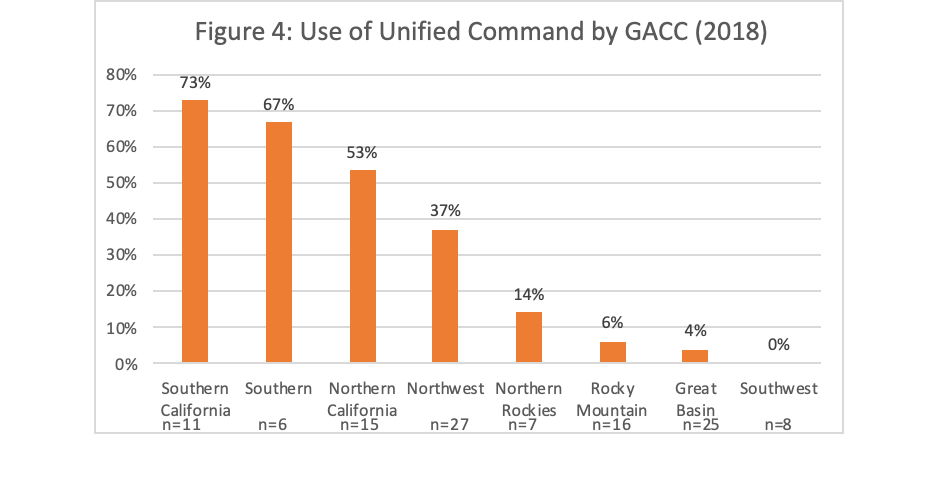
Lessons Learned
Our 2018 jurisdictional complexity analysis offers a national picture of the landscape of jurisdictional complexity of wildfire. These data validate that co-management across jurisdictions was a common feature of incident management for NICC reported Type 1 and 2 teams in 2018. This is to be expected on some level, as jurisdictional complexity is part of the analysis used to determine the need for higher level teams. The question is whether our current tools and co-management practices are well-suited to the degree of complexity that we are seeing on wildfires today.
Governing an incident across multiple land management jurisdictions generally means:
- negotiating potentially competing priorities and objectives, often under conditions of both uncertainty and limited resources;
- communicating effectively despite different agency cultures and assumptions about “how things are done”;
- and making strategic decisions about the type of fire organization that will be best suited to handle this complexity.
This raises important questions about the type of capacity needed to manage large scale wildfires in this complex environment. Are our current tools, knowledge, and jurisdictional relationships where they need to be? These are pressing questions for the fire community to consider given the role of climate change and continued expectations of fire size increasing with the attendant consequences of affecting larger land bases and their jurisdictions.
Further reading
https://fireadaptednetwork.org/co-managing-wildfire-conversations-you-need-to-have-right-now/.
Fire Chasers Network – North Carolina State University. https://research.cnr.ncsu.edu/blogs/firechasers/.
Comfort, L. K., Dunn, M., Johnson, D., Skertich, R., & Zagorecki, A. (2004). Coordination in complex systems: increasing efficiency in disaster mitigation and response. International Journal of Emergency Management, 2(1-2), 62-80.
Faas, A. J., Velez, A. L. K., FitzGerald, C., Nowell, B. L., & Steelman, T. A. (2017). Patterns of preference and practice: bridging actors in wildfire response networks in the American Northwest. Disasters, 41(3), 527-548.
Kapucu, N. (2009). Interorganizational coordination in complex environments of disasters: The evolution of intergovernmental disaster response systems. Journal of Homeland Security and Emergency Management, 6(1).
Nowell, B. and Stutler, J (forthcoming). Public Management in the Era of the Unprecedented: Dominant Institutional Logics as Barriers to Sensemaking. Manuscript in press with Perspectives in Public Management and Governance
Nowell, B. Steelman, T., *Velez, A, and *Yang, Z (2018). The structure of effective governance of disaster response networks: Insights from the field. American Review of Public Administration, 48(7): 699-715.\
Nowell, B., & Steelman, T. (2019). Beyond ICS: how should we govern complex disasters in the United States?. Journal of Homeland Security and Emergency Management, 16(2).
Steelman, T., & Nowell, B. (2019). Evidence of effectiveness in the Cohesive Strategy: measuring and improving wildfire response. International Journal of Wildland Fire, 28(4), 267-274.
References
Fleming, C. J., McCartha, E. B., & Steelman, T. A. (2015). Conflict and collaboration in wildfire management: The role of mission alignment. Public Administration Review, 75(3), 445-454. Retrieved from https://doi.org/10.1111/puar.12353
National Interagency Fire Center. (n.d.). Retrieved from https://www.nifc.gov/fireInfo/fireInfo_statistics.html
